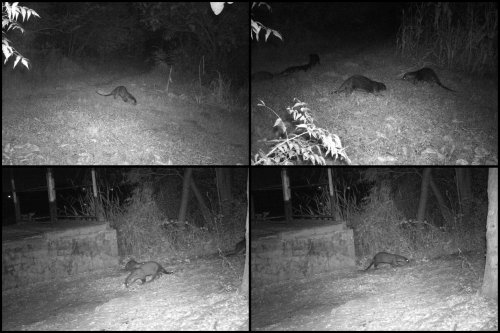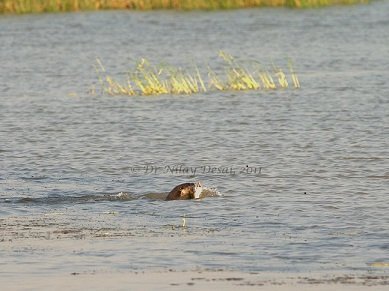IUCN/SSC Otter Specialist Group Bulletin

©IUCN/SCC Otter Specialist Group
Volume 35 Issue 1 (January 2018)
Citation: Trivedi, K and Joshi, P (2018). Photographic Documentation and Distribution of Smooth-Coated Otter (Lutrogale perspicillata) (Geoffroy 1826) in Surat, Gujarat. IUCN Otter Spec. Group Bull. 35 (1): 31 - 36
Photographic Documentation and Distribution of Smooth-Coated Otter (Lutrogale perspicillata) (Geoffroy 1826) in Surat, Gujarat
Krunal Trivedi1* and Prashant Joshi2
1 26, Kasturba Mahila Society, Palanpur Patiya, Surat (395009), India Email: lovetoliveinwild@gmail.com
* Corresponding Author
2C-304, Shiv Residency, Shankar Nagar, Nr. Palanpur Patiya, Surat (395005), India
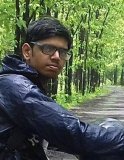 
|
| (Received 23rd July 2017, accepted 5th September 2017) |
| Download PDF (737 KB) |
| Abstract: A group of Smooth-coated otter (Lutrogale perspicillata GEOFFROY 1826) was sighted at Gavier lake of Nature Club Surat. This group of otter was documented by Nature Club Surat with the help of camera traps. Nature Club Surat has also identified five other sites where indirect signs of otters were found. In March 2014 otters were sighted for the first time in Gavier Lake but no photographic evidences were found at that time. (http://timesofindia.indiatimes.com/city/surat/Endangered-otters-back-in-Gavier-lake/articleshowprint/31931076.cms?null). According to presently available data and information of Gujarat State Forest Department, smooth-coated otters are only found in Narmada River system and surrounding water sources such as wetlands, lakes, canals and streams. |
| Keywords: Smooth-coated otter, Aquatic Mammal, Surat, Gujarat |
| Française | Español |
INTRODUCTION
Smooth-coated otter (Lutrogale perspicillata) is listed as vulnerable in the IUCN Red List (http://www.iucnredlist.org/details/12427). The species is protected under Schedule II of Wildlife Protection Act, 1972 of India. It is listed in appendix II of CITES (CITES 2014). Smooth-coated otter are widely distributed in Southeast Asia but very little information is available on the status of Smooth-coated otter populations in Gujarat state as well as India, although there seems to have been a rapid decline due to loss of habitat and intensive poaching (Hussain et al., 2008). Being the apex predator in their ecosystem, they are well adapted to semi-aquatic life and majorly thrive in areas where fresh water is plentiful, including wetlands, rivers, lakes and mangrove forests. Smooth-coated otters are among the least studied animals in India. There is very less information available on their distribution in Gujarat. Smooth-coated otters are part of illegal trade for their skin and bone, and there is high demand of their body parts in illegal market (http://www.otterspecialistgroup.org/Library/Colloquium_10/Presentations/10-10-16-20_Alarming_Trade_Paul_Yoxon.pdf).
Surat city is unique in availability of water sources as it is well connected by canal networks, wetlands, ponds, lakes, and the Tapi River along with the adjacent coast of Gulf of Khambhat provides mangrove habitat in which otters could survive. These areas provide otters with a range of food choices including fish, crustaceans, small birds and mammals, water snakes and amphibians.
Surat is mainly covered by agricultural landscape. This agricultural landscape is well connected by irrigational canals which are likely the main waterways for smooth-coated otters to commute from one water body to another. Smooth-coated otters were observed for the first time in Gavier Lake (Fig. 1) of Nature Club Surat which is situated near Surat airport. It is waterbody rich in biodiversity. Nature Club Surat has planted more than 1500 native trees which attracts birds and butterfly. Gavier Lake is home of more than 50 native bird species which are nesting at Gavier lake and around 150 species of migratory birds are recorded during winter season. In November 2015 the Nature Club Surat team sighted otters once again in Gavier Lake and decided to document them by camera trapping. Camera traps were installed in Gavier Lake and on the first day itself the camera trap recorded a group of five smooth-coated otters. Later camera trapping was continued for more than a month for documentation and good photographs.
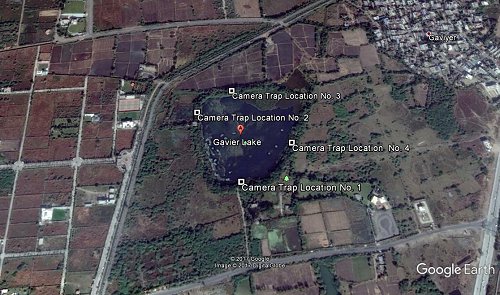 |
| Figure 1. Camera trap locations for documenting otters at Gavier Lake (click for larger version) |
METHODOLOGY
Camera trapping and sign surveys were the main methods employed. Two infrared camera traps of Cuddeback model C2 were used and installed in various locations of the Gavier Lake (Fig.1). Every three days camera trap were checked and data collected. This process was repeated for six weeks during the peak of the activity season (2nd week of October, 2015 to the 1st week of January, 2016). Smooth-coated otters were identified by comparing images and video footages with field guides and published literature (Menon, V. 2014). Moreover we also compared the images and video footages with the live specimens of smooth coated otters housed at Surat city zoo. We also surveyed other water bodies of Surat outskirts such as lakes, wetland, canals and mangroves areas to search for indirect signs of otters such as tracks and spraints.
RESULTS
On the first day after setting a camera trap recorded a group of five smooth-coated otters (Fig. 2). Later camera trapping was continued for more than a month for documentation and photographs and videos were collected.
Surveyed other water bodies of Surat outskirts of Surat such as lakes, wetland, canals and mangroves areas revealed evidences of smooth-coated otters at seven sites (Tab.1).
| Table 1: Sites were Smooth-coated otters indirect signs were found in Surat outskirts: | ||||
| Sr. No. | Site Name | GPS Coordinates | Direct Sighting/Indirect Signs | Season during Sighting & Survey period |
| 1 | Gavier Lake | 21º07'38.5" N 72º44'02.3" E |
Direct Sighting & Indirect Signs (Tracks & Spraints) |
Winter (Seven weeks) |
| 2 | Lake near Olpad village | 21º19'29.9" N 72º44'33.1" E |
Indirect Signs (Spraints) |
Winter (Two Weeks) |
| 3 | Barbodhan Lake | 21º13'12.4" N 72º42'11.7" E |
Indirect Signs (Tracks & Spraints) |
Winter (Two Weeks) |
| 4 | Mindhola River | 21º5'32.7" N 72º5'34.8" E |
Indirect Signs (Tracks & Spraints) |
Monsoon (One Week) |
| 5 | Kukni village canal | 21º14'49.7" N 72º43'20.0" E |
Direct Sighting & Indirect Signs (Spraints) |
Winter (Two Weeks) |
| 6 | Hazira mangroves | 21º6'0.5" N 72º41'7.6" E |
Indirect Signs (Spraints) |
Summer (Three Weeks) |
| 7 | Tena Lake | Direct Sighting (by Dr. Nilay Desai) Indirect Signs (Spraint & Tracks) (Fig. 3) |
Winter (Two Weeks) |
|
DISCUSSION
Smooth-coated otters are adapted to live near human populations and migrate through the canal network. It was observed that otters are not habituated to human presence. Being nocturnal, most activity is observed at night in the field areas. They are also found crossing roads in certain areas. We have found fish bones, small particle of turtle shell, and feathers in their spraints (Fig. 4). We have found them most active during winter, visiting various ponds in search of food. During summer and monsoon, they are mostly seen near estuarine areas by local people.
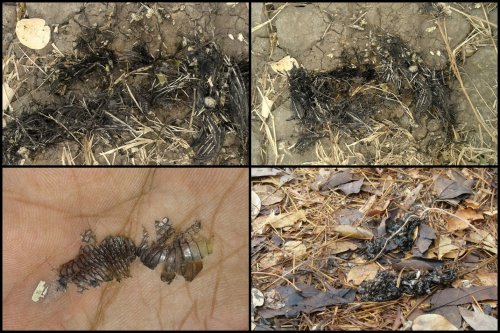
|
| Figure 4. Camera trap locations for documenting otters at Gavier Lake (click for larger version) |
In the Surat district and other surrounding villages, smooth-coated otters are mainly sighted near aquaculture farms such as the prawn farm. They are observed feeding on prawns and fishes at the farm. The farm owner suffer financial loss as otters destroyed their prawn cultivation, and sometimes the farm owner tries to kill otters (no evidence available, just information shared by local people). Pollution is also a threat to them. The fishing community also needs to be aware of their presence and importance. Being sensitive towards the environmental changes, smooth-coated otters are suitable indicators for the health of wetland ecosystems (Nawab, 2009). They are the topmost predator in this freshwater ecosystem. Conservation measures are required for smooth-coated otters and their habitat. Local people and fishermen will be targeted for education and outreach programs in order to build locally driven conservation actions. This will ensure the self-sustained conservation of the species in the area, encompassing micro and macro habitat protection.
Acknowledgements: We express our gratitude to Mr. Raju Vyas, Mr. Snehal Patel and Mr. Ashish Vakil for constant encouragement and support. We would like to thank Dr. Nilay Desai for providing otter images. We would also like to thank team of Nature Club Surat for assisting during field works especially Mr. Mukesh Vasava.
REFERENCES
Hussain, S.A., De Silva, P.K., Feeroz, M.M. (2008). Lutrogale perspicillata. In: IUCN 2013. IUCN Red List of Threatened Species. Version 2013.2. <www.iucnredlist.org>.
CITES (2014). Convention on International Trade in Endangered Species of Wild Fauna and Flora.Appendices I, II and III, valid from 14 September 2014.
Menon, V. (2014). Indian Mammals: A Field Guide. Hachette Book Publishing India Pvt. Ltd.
Nawab, A. (2009). Aspects of the ecology of Smooth-coated Otter Lutrogale perspicillata Geoffroy St. Hilaire, 1826: A Review. J. Bombay Nat. Hist. Soc. 106: 5-10.
The Wild Life (Protection) Act, 1972 (As amended up to 2006) (2008). TRAFFIC India, WWF India, New Delhi. Natraj Publishers, Dehradun. Menon, V. (2014). Indian Mammals - A field guide. Hachette book publishing India Pvt. Ltd. 300-301.
Résumé : Reportage Photographique et dDistribution de la Loutre à Pelage Lisse (Lutrogale perspicillata) (Geoffroy, 1826) dans le Surat, État de Gujarat
Un groupe de loutres à pelage lisse (Lutrogale perspicillata Geoffroy, 1826) a été observé au lac Gavier du Club Nature de Surat. Ce groupe a été étudié par le Club Nature Surat à l'aide de pièges photographiques. Le Club Nature de Surat a également identifié d'autres sites où des indices de présence indirects de loutres ont été trouvés. En mars 2014, des loutres ont été observées pour la première fois au Lac Gavier, mais aucune photo probante n'a été prise à cette occasion. (http://timesofindia.indiatimes.com/city/surat/Endangered-otters-back-in-Gavier-lake/articleshowprint/31931076.cms?null). Selon les données disponibles actuellement et les informations du Département de la Forêt de l'Etat de Gujarat, les loutres à pelage lisse sont uniquement présentes dans le réseau hydrographique de la rivière Narmada et à proximité des ressources en eau telles que zones humides, lacs, canaux et ruisseaux.
Revenez au dessus
Resumen:Documentación Fotográfica y Distribución de la Nutria Lisa (Lutrogale Perspicillata) (Geoffroy 1826) en Surat, Gujarat
Un grupo de nutria lisa (Lutrogalle perspicillata GEOFFROY 1826) fue avistado en el lago Gavier (en el Club de Naturaleza Surat). Este grupo de nutrias fue documentado por el Club de Naturaleza Surat con la ayuda de cámaras-trampa. En este club fueron también identificados otros cinco sitios en los cuales se encontraron signos de nutria. En Marzo de 2014 fueron vistas nutrias por primera vez en el Lago Gavier, pero en ese momento no se encontraron evidencias fotográficas (http://timesofindia.indiatimes.com/city/surat/Endangered-otters-back-in-Gavier-lake/articleshowprint/31931076.cms?null). De acuerdo a los datos disponibles actualmente y a la información del Departamento Estatal de Bosques de Gujarat, las nutrias lisas se encuentran solamente en el sistema del Río Narmada y ambientes acuáticos vecinos, como humedales, lagos, canales y arroyos.
Vuelva a la tapa
